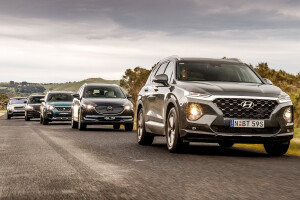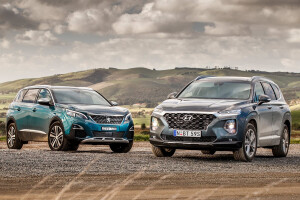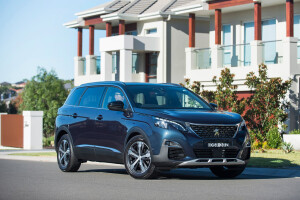Latest Review
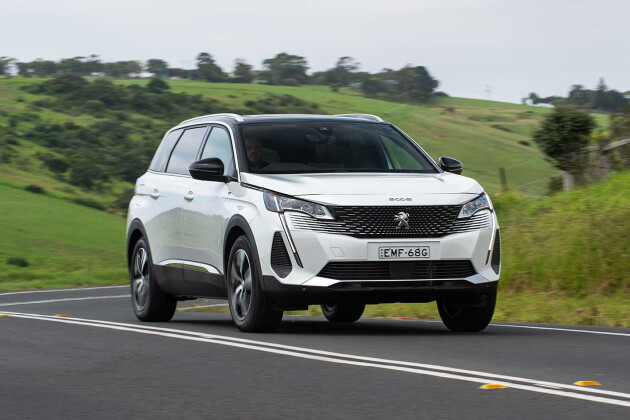
2021 Peugeot 5008 GT Petrol review
Seven-seat practicality in a suave French SUV package
The wheels are spinning furiously at Peugeot-Citroen Australia with the concurrent launches of all-new small 2008, face-lifted mid-size 3008 and this, the mid-life update for its categorically large seven-seat 5008 SUV.
All follow in the design wheel tracks of the marque's reimagined 508 in what is said to be a decade-long development of range unification to present a fresh identity bold and different enough to warrant a new Peugeot brand logo.
And the almost genre-blurring 5008, arguably more jacked up MPV than proper SUV in some respects and certainly petite by most seven-seat measures, has a key role to play, even if its MY21 makeover centres most conspicuously on styling changes applied to a single GT variant grade.
What's new? Refreshed LED lighting, a revised frameless grille and new signature 'three-claw' taillights with sequential indicators assimilate the contemporary family look outside, together with a new wheel design.
Inside, the old 8.0-inch touchscreen infotainment system has been replaced by a larger 10.0-inch format and tweaked content for the 12.3-inch digital driver's screen for Peugeot's oddball i-Cockpit format comprise noteworthy if not immediately apparent changes.
One grade, two engines. The petrol version fits a turbocharged 1.6-litre 'Puretech 165' petrol four producing 121kW at 6000rpm and 240Nm from 1400rpm, driving the front wheels via a conventional six-speed automatic transmission.
Meanwhile, the flagship choice is the lustier 2.0-litre BlueHDI 180 diesel four outputting 131kW at 3750rpm and 400Nm at 2000rpm backed by an eight-speed slushbox.
Yes, they're the same powertrains found in the segment-smaller 3008 GT, and in 5008 form there's a fair price discrepancy between the petrol GT on test here, at $51,990 before on-roads, the diesel version commanding an extra eight grand at $59,990 list. Big difference.
The oiler fills out the fiscal wedge to some degree by offering larger 19-inch wheels and adding Alcantara seating as well as a whizz-bang 515-Watt Focal audio system.
Given Australia's waning interest in diesel passenger vehicles, it's the petrol GT tasked with luring the lion's share of buyers away from obese seven-seat barges and into a more svelte and stylised French alternative.
At just 4.64 metres overall with a mere 194mm extra in length over its five-seat stablemate, the 5008 does feel a bit more like a stretched 3008 than a certifiable step up in category, an impression exacerbated by its trim form and quasi-crossover proportions. It's also shorter than rivals such as Volkswagen Tiguan Allspace and Skoda Kodiaq.
Given both the 5008 and smaller 3008 facelifts were both launched on the same program, it was easy to compare what are clearly many more tangible similarities than distinct differences between them, despite the pair lobbing quite different pitches.
For one thing, their cabin designs are almost uniform, flopped from quite similar moulds and differing only a little in the sense of spaciousness and in detailed execution.
And either model's interior is certainly a most striking departure from mainstream convention that might swoon those with adventurous tastes but will be a deal-breaker for others.
It's been around for a while now, so Peugeot's i-Cockpit, locating a tiny wheel underneath the line of sight of the instrumentation, has enough fans to secure its longevity.
But its ergonomic cohesiveness and user-friendliness varies from slightly odd and off-putting (5008) to downright disruptive (2008, old 308), where the latter's wheel placement completely obscures instrument vision in any usable wheel height adjustment.
The 5008 is the most palatable of the breed because its functionality doesn't trip over itself quite so unconvincingly. Arresting and annoying in roughly equal measure, too, is the asymmetric console 'hook' and orientation of almost all of the cabin controls towards the driver.
It brings a sense of occasion and interest to the look for front-row occupants and perhaps works a treat in a driver-selfish cabin space such as an exotic sportscar – Audi's R8 does it well.
But in an SUV it's more of a middle finger to the front passenger, obscuring easy access to the phone cubby, the USB ports, driver-oriented infotainment screen and associated short-cut buttons.
From the box seat, there's plenty of feel-good eye-candy and splashes of upmarket goodness to help elevate the 5008 above mainstream rivals and into the more premium tier Peugeot aspires to play in.
The configurable i-Cockpit display skins can look terribly fussy and the metallic shortcut 'flap' switches are downright bizarre, but the distinctive ambience they bring while effectively streamlining the cabin look is quite inspired.
What really lifts the accommodation is the seating, what with its sumptuous full-grain Nappa leather, fetching grey stitched patterning and massage-functional excess, at least for the driver. Thing is, it's a $3590 upgrade.
Add our tester's premium paintwork and near-$57k list will sail north of $60k on the road as sampled. The regular pews are Alcantara and fake leather with mechanical adjustment and the jury is out on their comfort and support, though 5008 does offer the rather nifty flat-folding front passenger seat.
The 'stretched 3008' effect pays big dividends in row two, which offers excellent legroom (and a flat floor) provided the 40:20:40 split-fold and tilt-adjustable seats are jammed most rewards on their rails.
As a five-seater, it's airy and roomy, though the narrow nature of the 5008 body style means that shoulder room is a little tight for what's pegged as a large SUV. It's a nice fit-out, too, including manual window blinds, dedicated fan speed controls for the rear air vents, and both 12v and USB ports.
The row two seats can also fold completely flat – 5008 makes one helluva surrogate delivery van – providing reasonably effortless access to the third row for the youngsters who brave the rear seats, which also sprout cleverly from the flat cargo area floor.
Accommodation is tight, though, and adjusting any semblance of legroom demands row two seating is adjusted forward on its rails.
Thus, proper seven-seat occupancy is ultimately a balancing act, and it's not the commodious option if all seats are in regular use. But as a confidently comfortable and roomy five-seater with a big boot (952 litres) and occasional 'emergency' seating, or a dedicated five-seater with row three removed completely (1060 litres), the 5008 starts to make pragmatically practical sense.
A seven-seater with 1.6-litre motivation hardly makes for a pulse-raising recipe. If a larger-capacity heartbeat is a priority, best look in the direction of something such as the 162kW Volkswagen Tiguan Allspace.
That said, the 5008 is, at just over 1550kg kerb, impressively lightweight and not much heavier than the 3008 with which it shares its powertrain.
Acceleration is 10.5 seconds to triple figures – 0.3sec swifter in diesel form – but what it lacks in sheer thrust it partly makes up for with blossoming low-to-mid-range torque and a cooperative auto.
It's tractable and flexible enough around town, at least unencumbered to capacity with loved ones and luggage, and is surprisingly frugal on the motorways with adaptive cruise control engaged.
Just don't get too enthusiastic about lunging for gaps or dicey overtaking maneuvers because there's little energy in its reserves once you punch the loud pedal.
Consumption is, at 7.0L/100km claimed, bang on the 3008 GT's claim. On test, it tended to dwell in the five- to six-litre mark on the open road and soar into double figures around town, settling into a more genuine nine-litre thirst across real-world conditions. Not bad, but you'll have to stump for the diesel to reduce the hit on the hip pocket much further.
It's shame that the fitter and more frugal 'Puretech 180' 1.6-litre four in the smaller SUV's GT Sport flagship isn't offered in the 5008, as it brings 12kW more power and 10Nm torque together with sharper performance and better fuel economy, aided by an eight-speed transmission.
Despite the modest heartbeat, it's quite a refined powertrain with a silken character that doesn't sonically betray some of the obvious heavy lifting it's tasked with.
It slips through ratios sedately, the auto plucking enough tractive effort without the need to touch the superfluous column-mounted shifters, and Sport mode adds a muted sense of purpose that offers a bit of handy, unflustered purpose running around urban back streets.
Most impressive the refinement. On the move, the 5008 feels gun-barrel tight and remains impressively impervious to road and wind noise, bringing with it a nice premium sheen of the likes Peugeot likes to spruik loudly and proudly.
The steering is a little inert and lacks much in the way of communication but the chassis plants itself nicely and cooperates with the driver in a manner many larger seven-seaters can't muster.
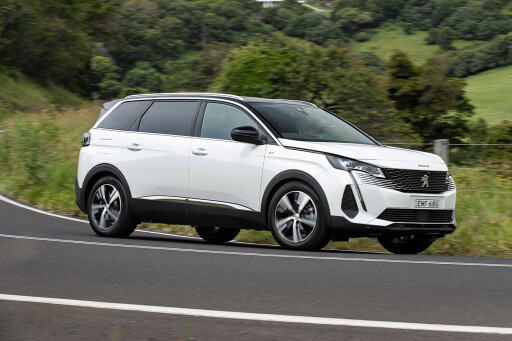 It feels like an extended 3008 – itself a fine drive – if a bit more planted and stable, perhaps due to the markedly longer wheelbase.
It feels like an extended 3008 – itself a fine drive – if a bit more planted and stable, perhaps due to the markedly longer wheelbase.
The real highlight is the ride comfort, specifically how controlled the passive damping is. East Coast Australia's rain deluge left its roads terribly pockmarked with severe potholes, almost all of which the 5008's 55-series 18s negotiated with a mild thump and no sharp suspension noise.
Attack speed humps and the suspension compresses beautifully then settles on rebound instantly and confidently. Usually, you'd have to dive into an adaptive system's softest setting for such a pliant ride and even then rarely without the sort of residual body control the 5008 seemingly has in reserve. On-road, this is the real highlight.
Its narrow form and relatively short length, combined with decent outward visibility, means the 5008 is easier to park in the sort of tight spots you'd otherwise have to shoehorn a properly large SUV into. The only real sore point is the woefully grainy reversing camera with pitifully small viewing perspective in the display screen.
Safety-wise, the 5008 is so closely related to 3008 in terms of structure that the latter's crash testing results we used for the five-star ANCAP assessment of the former. However, other considerations, such as the seven-seater's curtain airbag coverage extending through to the third row, also contributed to the 2017 report, which scored zero for AEB functionality due to its then absence.
Today's version is updated and technically uplifted, its safety fit-out including the updated-for-MY21 all-speed autonomous emergency braking with low-light pedestrian and cyclist detection, forward collision warning, driver attention alert, speed sign recognition and indication, blind-spot monitoring, lane departure warning and active lane keeping, as well as ISOFIX mounting points in the rear outboard seating positions.
Peugeot offers five years of unlimited-kilometre warranty on its passenger vehicles for private use. The good news is that there's a long 20,000kms of grace between (otherwise annual) servicing intervals, though the bad news is the per-visit outlay.
Pricing ranges from $397 through to a whopping $806 over the first five years, a total outlay of $2803 that averages out to just over $560 per year.
In its own stable, the four-grand step up from the smaller 3008 GT petrol might entice buyers after 'emergency' seven-seat flexibility or those simply after more room as a spacious dedicated five-seater, where arguably the 5008 works a little more convincingly.
Those after maximum metal, glass, rubber, space and engine output for their hard-earned probably won't short-list the French option that hangs style and design as its biggest dangling carrots. But that it's not for everyone is in itself an attractive trait for some buyers.
Better still, the 5008's comparatively trim package brings many pluses. It runs and drives lean, isn't cumbersome to drive and is easy to live with in the confines of the urban environment.
It's an oh-so-European formula with achingly French ostentatiousness, which is central to grabbing your attention but this seven-seater backs it up with plenty of depth in many good places.
Verdict: 8/10
Likes: Decent room and cabin flexibility; upmarket vibe to match the flashy styling; polished on-road ride comfort
Dislikes: Lack of performance; pricey (particularly when optioned); i-Cockpit design not for all tastes; not the roomiest third row
Specifications
Body: 5-door, 7-seat SUV
Drive: front-wheel
Engine: 1598cc inline-4cyl, DOHC, 16v, turbocharged
Bore/stroke: 77.0 x 85.8mm
Compression: N/A
Power: 121kW @ 6000rpm
Torque: 240Nm @ 1400rpm
0-100km/h: 10.5sec (claimed)
Fuel consumption: 7.0L/100km (combined/claimed)
Weight: 1553kg
Power/weight: 78kW/tonne
Transmission: 6-speed automatic
Suspension: struts, coil springs, anti-roll bar (f); torsion beam, coil springs, anti-roll bar (r)
L/W/H: 4641/1844/1646mm
Wheelbase: 2840mm
Tracks: 1601/1593mm
Steering: electrically assisted rack-and-pinion
Brakes: N/A (f); N/A (r)
Wheels: 18 x 7.0-inch (f/r)
Tyres: 225/55 R18 (f/r)
Price: $51,990 plus on-road costs
News
-
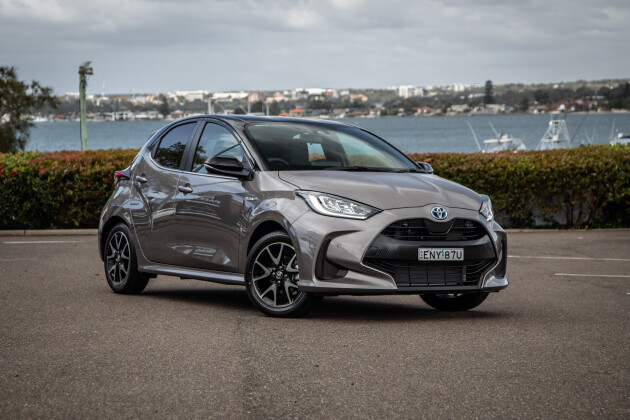 News
NewsAustralia's most fuel-efficient cars in 2022
Here's every car without a plug, on sale now, that sips five litres per 100km – or less
-
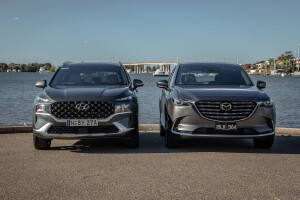 News
NewsEOFY 2022: Best deals on medium and large SUVs
Looking for a good deal this EOFY season? Look no further – we've found you all the latest offers for the segment
-
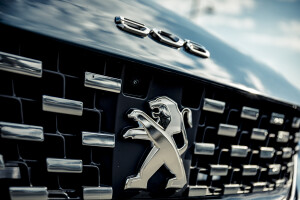 News
News2022 Peugeot pricing increased across model range
Increased production costs are being passed on to customers
-
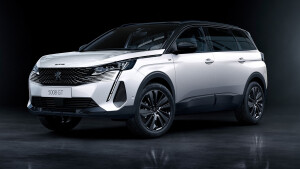 News
News2022 Peugeot 5008 range expanded with GT Sport variant
Regular GT trim dropped in favour of GT Sport for petrol buyers
-

Facelifted Peugeot 3008, 5008 on sale in Australia
-
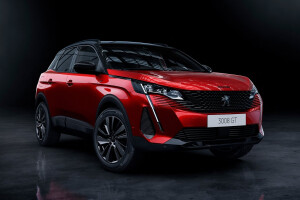
2021 Peugeot 3008 to offer plug-in hybrid for Australia
-
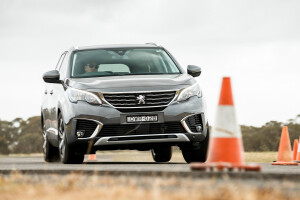
Peugeot 5008 2019 Car of the Year review
-

Peugeot 3008 and 5008 Crossway Editions pump up the volume



